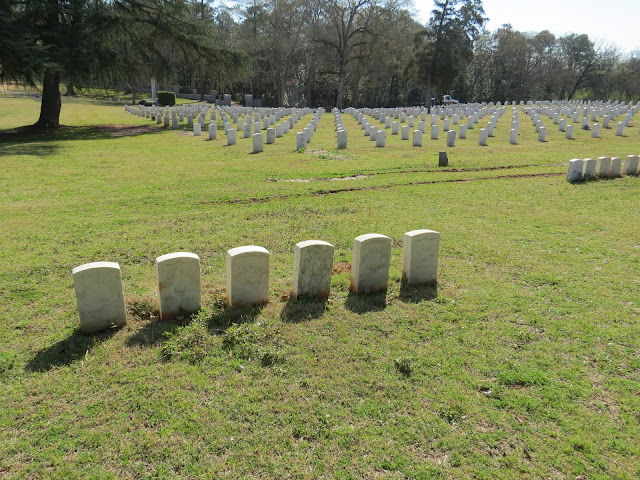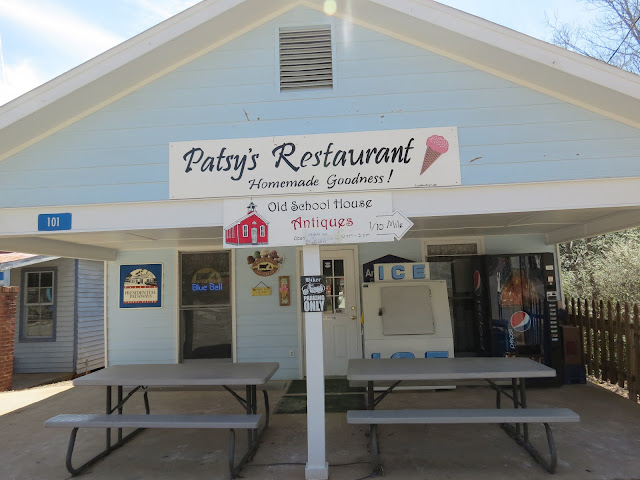They arrived by train after a journey of several days, packed so tightly in the train cars, they could not sit down.
The depot as it looks today.
Trains still pass by daily, but they no longer stop in Andersonville.
When the train stopped at Andersonville, GA, the Union prisoners were ordered off and marched a quarter mile to the stockade.
An account of one survivor:
The north gate that prisoners entered has been accurately reconstructed based on archeological findings and historical accounts.
The original lock, key and, hinge are on display in the museum.
There were two sets of gates. Once inside the first, that gate was closed and the inner gate opened.
Entering the prison today this is what you see.
This is what the new prisoners saw in 1864. There was no grass or other vegetation growing inside the prison.
The site of the prison was once a pine forest, similar to the one that surrounds the grounds today.
Slaves were impressed from local plantations to fell the trees, trim and cut the logs in 20 foot lengths. The logs were used to build the stockade with walls 15 feet high.
The logs were buried five feet deep to discourage tunneling.
Sentry boxes were placed every hundred feet. A "deadline," 20 feet inside the stockade marked by slat-topped poles, was established to prevent prisoners from attempting to scale the walls. Guards were told to shoot to kill any prisoner even extending a limb over the line, a rule that was enforced on several occasions.
As the first Union soldiers arrived on February 25, 1864, they found no housing and no sanitary facilities, but simply a huge corral in which they were penned.
Haphazardly they built "shebangs," shelters of any material they could find. These included huts and lean-tos from tree limbs or brush left inside the walls, blankets and overcoats they had with them. Only the early arrivals were lucky enough to find materials to build a shelter.
Newcomers, lacking materials, dug holes in the side of a hill for shelter.
Fires were small as wood for burning was minimal. Rations were a quart of corn meal, so coarsely ground it was hard to digest. Occasionally a sweet potato and a few ounces of salt meat were added, but later in the war that was no longer available. Prisoners prepared the meal by mixing with water and making mush, or baking hoe-cake on a piece of tin.
Their only source of water was a small stream flowing through the center of the prison.
The "upstream" side is where prisoners drew their drinking water. This soon became polluted because of discharge from the guard's camps outside the prison.
The stockade walls also slowed the flow, and the area soon became a quagmire.
Some prisoners resorted to digging wells with the only tools they had, their mess spoons.
Not much water was gotten from these wells.
Several such wells have been located and marked by the National Park Service.
The latrine was on the downstream side and meant to flush waste out of the prison. Instead the sewage backed up and the whole area became a polluted swamp.
The "Sinks" as they appear today.
Dysentery and diarrhea swept the camp, and prisoners began dying daily.
Any small scratch or wound became infected and gangrene set in. A trip to the hospital usually meant amputation of the infected part. Biting the bullet was the only anesthesia for an operation.
With no way to fight infections, a trip to the hospital was a death sentence for most.
The same wagon that brought their rations also carried away the daily dead.
The number of dead became so many that caskets and individual graves were not possible.
Long pits were dug and the dead were buried shoulder to shoulder, stripped of any usable clothing.
Some soldiers blamed the Union for their plight, feeling hopelessly abandoned because the Union stopped allowing prisoner exchanges.
But most blamed Captain Henry Wirz, commander of the prison from 1864 to the end of the war. After the war he was arrested, tried and hanged as a war criminal.
Captain Wirz
Many prisoners attempted to escape by tunneling under the stockade. A tree grows from the remains of this tunnel. Tunneling began inside a shelter and took a long time to complete due to lack of digging tools, the hard red clay, and no way to shore up the tunnel.
The few who succeeded in reaching the outside were soon captured by hound dogs.
In addition to deprivation, disease, lice and other vermin, the prisoners had another problem from within their ranks. Gangs called raiders attacked other prisoners to steal whatever they could.
The prisoners got permission to form a vigilante group called the"Regulators" to attack and capture the Raiders. Six were "arrested", tried by the prisoners and hanged.
They are buried apart from the other prisoners and to this day their graves are undecorated.
Almost 13,000 Union soldiers who died at Andersonville are buried here.
Almost all of them have been identified and their names engraved on headstones.
That is the story of Andersonville, the Civil War Prison, but as with most stories there is another side.
The town of Andersonville has its own story to tell.
The town strives to honor both sides of the conflict.
Unlike the National Park which flies the US and POW flags, the town of Andersonville also flies the confederate flag.
After much controversy, the Daughters of the Confederacy succeeded in placing a monument here in memory of Captain Wirz.
The inscriptions on the four sides attempt to portray him as a scapegoat and martyr.
The site of Wirz's headquarters is identified.
A street is named after him.
Their ancestors who died for the Confederacy lie buried in the town cemetery.
They want their side to be remembered with honor.
There were those from outside who tried to help. The Catholic Church sent Father Whelan to minister to the prisoners. He stayed in a small shack in the village.
There is no evidence that local clergy made any efforts to provide comfort to the prisoners, in fact it is said that many local preachers warned congregations that rendering aid to the prisoners would be sinful.
There were some scattered instances of kindness from the community. One prisoner recorded this about a Mr. Bass who was in fear of his life for assisting the them.
Others organized relief efforts and succeeded in delivering food and supplies a few times, but later were turned away by prison guards.
I spent three days touring the prison and the town, immersing myself in the history. It was a town before the prison was built, but its story is forever intertwined.
The whole town is now an antique, and depends on people like me fascinated by history to subsist.
I stayed in the town campground,
Ate in its restaurant,
And visited its museum...which has an excellent collection of artifacts from Andersonville prison and other Civil War sites.
Thistle and I hiked the trails behind the campground,
Meeting the locals.
I liked the "No sagging pants" rule.
Pioneer farmhouse.
Andersonville Milling Co.
The Slosheye Trail was used first by Indians and white traders as early as 1750 and extended from Hawkinsville to Drayton. Had to look that up.
We walked the brick-paved sidewalks...
Thistle meeting another local.
Strolled through the old cemetery, dating to the early 1800s.
Studied old buildings,
And pondered all I learned.
This mural is at the National Park Visitor Center.
I think I just redefined how I will travel. I really enjoyed these three days getting to know a place and its history.












































































Fascinating post Liz; all new history to me; thanks for sharing it.
ReplyDeleteMy kind of trip!
ReplyDeleteWonderful, wonderful, wonderful, now thats
ReplyDeletewhat I want to see....I know what you mean
Such a sad time in history but it sounds like they did a good job of retelling the story. Glad you enjoyed your time relooking at history.
ReplyDelete